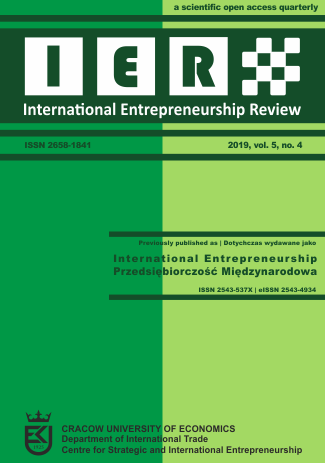The importance of swap transactions in the evolution of the Polish currency market and the OTC interest rate derivatives market

Abstract
Objective: The article aims to present the importance of swap transactions in the evolution of the Polish currency market and the OTC interest rate derivatives market.
Research Design & Methods: The theoretical considerations in the article were based on a critical analysis of the literature on the subject. In turn, the empirical part of this article was developed using numerical parameters characterizing the studied phenomenon.
Findings: It cannot be unequivocally confirmed that swaps, due to their universality and design, are the most frequently used instrument of the Polish currency market and the OTC interest rate derivatives market. This is because, although, on the currency market, the main share in transactions was achieved by currency swaps, in the case of the OTC interest rate market, interest rate swap (IRS) transactions no longer record the largest share.
Contribution & Value Added: The issue of swap contracts, according to the authors of the thesis, is the subject of limited interest in the Polish research literature, and this article was to be a response to the need to systematize knowledge about these instruments and a synthetic presentation of their development.
Author Biography
Robert W. Włodarczyk
Associate professor at the Department of Theory of Economics, Cracow University of Economics. Master’s degree in economics from Cracow University of Economics in 1999; PhD in economics from Cracow University of Economics in 2006; Dr hab. in economics from Cracow University of Economics in 2014.
Magdalena Sikorska
PhD student at Cracow University of Economics, College of Economis, Finance and Law. Master’s degree in economics from Cracow University of Economics in 2018; Engineer’s degree at Silesian University of Technology in 2018.
References
- Chisholm, A.M. (2009). An Introduction to International Capital Markets: Products, Strategies, Par-ticipants. Wiley Finance.
- Czekaj, J. (2008). Rynki, instrumenty i instytucje finansowe. Warszawa: PWN.
- Dąbrowski, P. (2010). Rynek finansowy. Katowice: Wydawnictwo Uniwersytetu Ekonomicznego w Katowicach.
- Dmowski, A., & Prokopowicz, D. (2010). Rynki finansowe. Warszawa: Difin.
- Gwizdała, J. (2013). Instrumenty pochodne w ograniczaniu ryzyka stopy procentowej w bankach komercyjnych. Finanse, Rynki Finansowe, Ubezpieczenia, 60, 442-443.
- Hull, J. (1997). Kontrakty terminowe i opcje. Wprowadzenie. WIG PRESS, Warszawa.
- Jajuga, K. (2009). Derivative instruments. Warsaw: Polish Financial Supervision Authority.
- Kolb, R. (1997). Wszystko o instrumentach pochodnych. Warszawa: WIG Press.
- Kukurba, M. (2016). Walutowe i procentowe transakcje zamiany – podstawy mechanizmu działania. Kwartalnik Kolegium Ekonomiczno-Społecznego Studia i Prace, 2, 25-26.
- Leszczyńska, E. (2003). Rynek kontraktów SWAP w Polsce. Warszawa: Narodowy Bank Polski.
- Lutkowski, K. (1998). Międzynarodowy system walutowy. Warszawa: Poltext.
- Malinowski, A. (2011). Zastosowanie kontraktów swap w Polsce. Zeszyty Naukowe Uniwersytetu Przyrodniczo-Humanistycznego w Siedlcach – Administracja i Zarządzanie, 88, 127-128.
- Martinkutė-Kaulienė, R. (2015). Risk Factors in Derivatives Markets. Entrepreneurial Business and Economics Review, 2(4), 71-83.
- Marynarski, S. (1999). Rynek opcji. Kraków: Wydawnictwo Uniwersytetu Ekonomicznego w Krako-wie.
- McDougall, A. (2001). Swapy. Kraków: Oficyna Wydawnicza ABC.
- NBP (2018). Derivative instrument. Narodowy Bank Polski. Retrieved from: https://www.nbportal.pl/slownik/pozycje-slownika/instrument-pochodny (02.04.2018).
- NBP (2004). The results of the turnover survey in April 2004 on the currency market and OTC deriva-tives market in Poland. Warsaw: National Bank of Poland.
- NBP (2007). The results of the turnover survey in April 2007 on the currency market and OTC deriva-tives market in Poland. Warsaw: National Bank of Poland.
- NBP (2010). The results of the turnover survey in April 2010 on the currency market and OTC deriva-tives market in Poland. Warsaw: National Bank of Poland.
- NBP (2013). The results of the turnover survey in April 2013 on the currency market and OTC deriva-tives market in Poland: National Bank of Poland. Warsaw.
- NBP (2016). The results of the turnover survey in April 2016 on the currency market and OTC deriva-tives market in Poland. Warsaw: National Bank of Poland.
- Rule, D. (2011). The credit derivatives market: its development and possible implications for finan-cial stability. Bank of England Financial Stability Review.
- Taylor, F. (2000). Rynki i opcje walutowe. Kraków: Oficyna Wydawnicza ABC.
- Trader’s Area. (2018). The most important derivatives in the world. Retrieved from: http://tradersarea.pl/najwazniejsze-instrumenty-pochodne-na-swiecie/ (02.04.2018).
- Tymuła, I. (2000). Swapy finansowe. Warszawa: Biblioteka Menedżera i Bankowca.
- Wolańska, A. (1998). Transakcje SWAP. Rynek Kapitałowy, 3.
- Zabielski, K. (2005). Finanse międzynarodowe. Warszawa: PWN.
- Zając, J. (2000). Polski rynek walutowy w praktyce. Warszawa: Wydawnictwo K.E. Liber.
